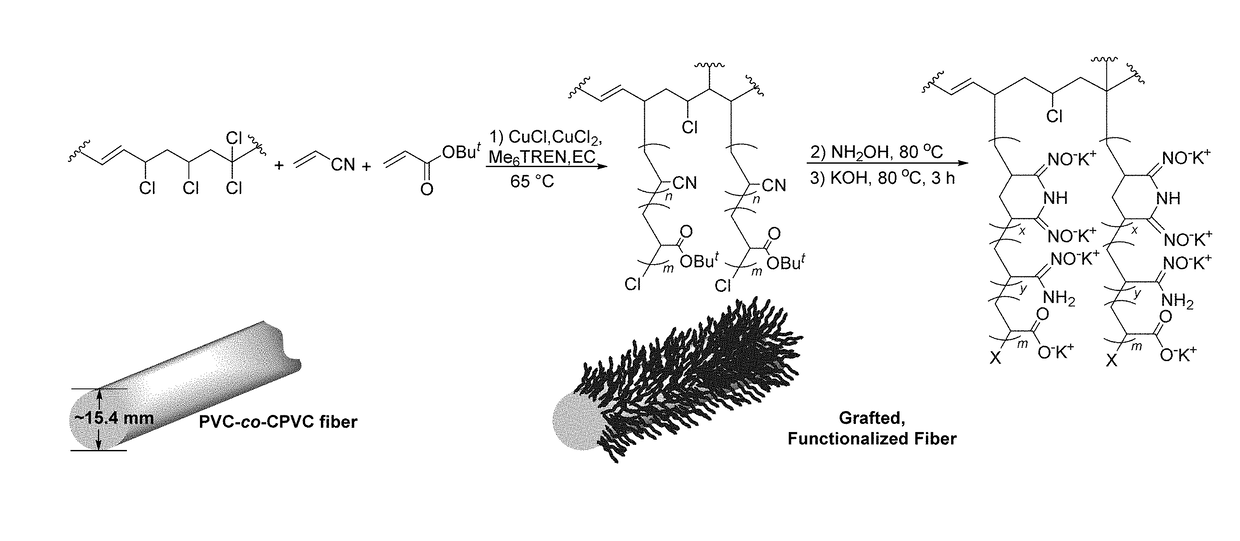Surface-functionalized polyolefin fibers and their use in methods for extracting metal ions from liquid solutions
a technology of surface functionalization and polyolefin fibers, which is applied in the direction of amphoteric ion exchangers, energy-based wastewater treatment, chemical/physical processes, etc., can solve the problems of high cost of operation when electron beam irradiation, limited choice of monomers, and many limitations, so as to achieve efficient functionalization, reduce cost, and facilitate large-scale commercial production
- Summary
- Abstract
- Description
- Claims
- Application Information
AI Technical Summary
Benefits of technology
Problems solved by technology
Method used
Image
Examples
example 1
Functionalization of PVC-co-CPVC Fiber with Amidoxime Groups and Use Thereof for Extraction of Uranium from Seawater
[0061]The following experiments involve SI-ATRP copolymerization of acrylonitrile (AN) and tert-butyl acrylate (tBA), a precursor for polyacrylic acid (PAA), from PVC-co-CPVC fiber for the preparation of fibrous uranium (U) adsorbents. Results with varied copolymer compositions, along with U adsorption results in U-spiked simulated seawater and actual seawater are reported. Other precursors for PAA, including 2-hydroxyethyl acrylate (HEA), 2-hydroxyethyl methacrylate (HEMA), ethyl 2-(hydroxymethyl)acrylate, 3-hydroxypropyl acrylate, 4-hydroxybutyl acrylate, or 3-(trimethoxysilyl)propyl methacrylate, may be used instead of tBA. As indicated, in some embodiments, it may be preferable for the PAA precursor to possess a hydrophilic group, such as a hydroxy-derivatized hydrocarbon group.
[0062]Preparation and Characterization of a Metal-Binding Fiber by SI-ATRP Deposition of...
example 2
Halogenation and Amidoximation of Polypropylene (PP) Fiber and Use Thereof for Extraction of Uranium from Seawater
[0085]In a similar manner to the above work on surface-initiated atom-transfer radical polymerization (SI-ATRP) from a commercial PVC fiber (Rhovyl® ZCS), the following work investigated the preparation of uranium adsorbents by SI-ATRP grafting from halogenated fibers.
[0086]Halogenation of Polypropylene Fiber
[0087]Trunk fibers were prepared by free-radical chlorination or bromination of polypropylene (PP) round fiber according to the following general schemes:
[0088]In chlorination, chlorine gas (Cl2) was generated in-situ by the reaction of sodium hypochlorite (NaOCl) and hydrochloric acid (HCl) and chlorine free radicals were generated either under sunlight or by UV irradiation (Shah, et al., Textile Research Journal, 1983, 53 (5), 274-281). In bromination, bromine radicals were generated by UV irradiation of liquid bromine (Balamurugan, et al., Polymer 2001, 42 (6), 25...
PUM
| Property | Measurement | Unit |
|---|---|---|
| diameter | aaaaa | aaaaa |
| adsorption capacity | aaaaa | aaaaa |
| diameter | aaaaa | aaaaa |
Abstract
Description
Claims
Application Information
 Login to View More
Login to View More - R&D
- Intellectual Property
- Life Sciences
- Materials
- Tech Scout
- Unparalleled Data Quality
- Higher Quality Content
- 60% Fewer Hallucinations
Browse by: Latest US Patents, China's latest patents, Technical Efficacy Thesaurus, Application Domain, Technology Topic, Popular Technical Reports.
© 2025 PatSnap. All rights reserved.Legal|Privacy policy|Modern Slavery Act Transparency Statement|Sitemap|About US| Contact US: help@patsnap.com



